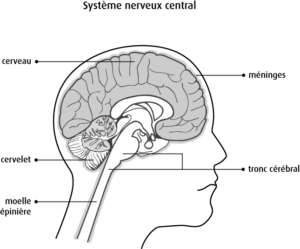Questions about Osteo-Maning
Answers from Pr Johan Pallud
Causes
Joyce : Having never taken a hormone or pill, can my meningioma (on meninges) be due to radiation…. Dental, mobile panoramic radio ...
Johan Pallud: The answer is clearly no. Radiations are a known risk factor for meningiomas but they correspond to particularly strong doses that are only encountered in two situations: 1) an irradiation of the skull and the encephalia at therapeutic doses for the treatment of a hematological disease in childhood (like leukemia); 2) Exposure during a nuclear accident.
What is an osteo-meningioma?
Mélanie : What is an osteo-meningioma, what is the difference with meningioma?
Johan Pallud: An osteo-meningioma is a meningioma which has a bone component, that is to say that the bone with regard to the Meninge where the meningioma is inserted was invaded by meningioma. The bone will therefore thicken at the same time as the meningioma will grow. We therefore speak of osteo-meningioma.
It is different from a calcified meningioma which presents calcifications within it and independently of the cranial bone. The presence of calcifications within a meningioma is proof of slow development since meningioma had time to calcify. Completely calcified meningioma is therefore a particularly slow, even zero developmental meningioma. However, MRI surveillance should be maintained
Valéry : What is the difference between osteo-meningioma and meningioma in plate?
Johan Pallud: a "plaque " meningioma simply means that the meningioma does not come in the form "of a ball" inserted on the meninge but that it comes in the form of a thickening spread over the mening, then giving the aspect of "a plate" of disease.
A plaque meningioma is readily associated with a bone invasion opposite and then constitutes an osteo-meningioma. This is often the case in the osteo-meningiomas of the spheno-orbital dihedral which have a large bone component and a meninged plate component.
Live with osteo-meningioma
Laetitia : Does an osteo-meningioma be a simple surveillance and that it never grows over the years, is living with all their life without worries? Can we hope to have a pregnancy with an osteo-meningioma?
Johan Pallud: an osteo-meningioma exposes in theory at the same evolutionary risks as a meningioma without bone component. If it does not generate any symptoms and if it does not grow over time, it is possible to monitor it. We can then "live with" subject to surveillance by MRI. A pregnancy can be envisaged when we wear a meningioma but it must be upstream confirming its strict stability and collecting the agreement of the neurosurgeon who follows you and informing the gynecologist.
Pascale : can a stable osteo-meningioma a few years evolve?
Johan Pallud: an osteo-meningioma exposes in theory at the same evolutionary risks as a meningioma without bone component. Stability of a meningioma documented by MRI over several years is an important element that signs zero or very slow growth of this meningioma. It is a good point even if it is necessary to maintain surveillance.
Delphine : Question 1: Are the control MRIs made in different centers this poses a problem to assess perfectly if the osteo-meningioma has stabilized or has slightly fat or conversely slightly lowered? With the coronavirus crisis difficult to be able to have appointments in the same place.
Johan Pallud: Control MRI can be done in different centers, this will not change the "size" of meningioma. On the other hand, radiologists must have previous IRMS to be able to make comparative and quantified monitoring of meningiomas.
Thus, you must always have in your archives all your IRMS in CD format and that on the MRI prescription is noted "comparative and asset analysis".
Delphine : Question 2: even being stability an osteo-meningioma that plays on the optic nerve can continue to cause increasingly important symptoms: Down Visual Field Headache ...?
Johan Pallud: I cannot precisely answer for your personal situation. However, the consequence of meningioma on a nervous structure can be linked directly to the growth of meningioma but also with the consequences it generates: edema, venous compression. Thus, symptoms can increase while meningioma itself does not increase.
Delphine : Question 3: Can an osteo-meningioma cause symptoms as in the general symptoms of meningiomas great fatigue. For my part a huge fatigue or even a feeling of being exhausted
Johan Pallud: Yes, it's possible. It is also possible that meningioma is not directly responsible for your feeling of great fatigue but that it is integrated into "a whole" which generates this fatigue. Wearing a chronic illness, even if it does not generate any direct symptoms, is a sometimes heavy burden.
Elvirette : My osteo-meningioma temple and left eye has grown with the symptoms that we know 9 years later! Today it has been stable for 5 years. Can he evolve again? Having aside the same meningioma side and which has been stable for 10 years and always the same questions?
Johan Pallud: Yes. An osteo-meningioma exposes the theory at the same evolutionary risks as a meningioma without bone component. Stability of a meningioma documented by MRI over several years is an important element that signs zero or very slow growth of this meningioma. It is a good point even if it is necessary to maintain surveillance.
Jannick : I have an osteo-meningioma right front-time followed by MRI, discovered 2 years ago after multiple arm or leg exams that paralyze at night and many other symptoms. 10 years of Lentenyl and 5 years of Sterilet Mirena. Today a great permanent fatigue, pBs of concentration and memory. But what to do when we hear ourselves say that all of this is not linked to osteo-meningiom when I feel very good that I am only the same than before and that it plays in my work. ALD refused. So what recognition to make it admit that someone is not going well even if you have to live with it. What future with osteo-meningioma, can it remain stable all the rest of life? Thanks to you.
Johan Pallud: As a statement higher, it is possible that your meningioma is not directly responsible for your feeling of great fatigue but that it fits into "a whole" which generates this fatigue. Wearing a chronic illness, even if it does not generate any direct symptoms, is a sometimes heavy burden. Your meningioma can also directly generate Genoa which are yours. In your case, it may be useful to carry out an evaluation of cognitive functions by a speech therapy which may attest to the certificate or not of such and such functions.

Operation or not
Operating and after -effects
Valérie : I had an excision on the optic nerve (left eye), I have 7mm inoperable, I am anxious to know how it will evolve? It is planned for radiotherapy if necessary in case it regards (plates meningiomas). I have no treatment since, even for menopause is there a risk that it will reguse? If so at what rate? Is there enough perspective at the moment?
Johan Pallud: I cannot answer such a precise question, not knowing your medical file. It is advisable to follow the recommendations for monitoring your doctors. In theory, a bullshit of meningioma can progress, but it is not certain because one can be dealing with a bullshit of meningioma "as death" which was certainly left in place by the neurosurgeon but which was devascularized by the surgical gesture. There is no data to predict the risk of recurrence in a given case, which explains systematic monitoring.
Hélène : Is an osteo-meningioma more difficult to operate than a meningioma? Is there more risk? There is a reconstruction to be done and access is sometimes difficult. What an impact tobacco on meningioma or osteo-meningioma. ? Smoking often get my headache. Can we live with osteo-meningioma and hope never to be operated on?
Johan Pallud: No, an osteo-mening is no more "difficult" to operate than a classic meningioma. The risks are not increased. Yes, there is a bone reconstruction to be made because the part of the bone invaded by meningioma must be removed. Tobacco aggravates everything and, as a doctor, I can only advise you to stop consumption. You will draw all the benefits, including on headaches. An osteo-meningioma explodes in theory at the same evolutionary risks as a meningioma without bone component. If it does not generate any symptoms and if it does not grow over time, it is possible to monitor it. We can then "live with" subject to surveillance by MRI.
Rheira : 22 months from my meningioma excision (here a right temporal of 6 cm), recovery is slowly, despite care, following the sequelae. Could I find an almost equivalent quality of life before the intervention?
Johan Pallud: I cannot respond to your particular case precisely. In general, convalescence, which is the period during which the body recovers surgery is between 3 and 24 months. At 22 months, in theory, recovery is acquired in terms of "body repair". You must therefore analyze what you are missing to have a quality life. To do this, you have to assess your physical capacities and your neurocognitive capacities but also your psychological state. This is important to know what has dropped, what is stable and what is improved in terms of capacities compared to the pre-operative state. Knowing your strengths and weaknesses will help you live as best as possible.
Nadia : I have an osteo-meningioma from Vertex with resection of the bone contingent operated last December. My history is an endometriosis of utero-sacred-electrocoagulation ligaments operated in 1990. Since that day, various treatments have been given to me therefore lutenyl, Androcur and Luteran continuously between 1990 and 2010. After 2010 I had other hormonal treatments until December 2019 where the neurosurgeon has said stop at all hormones since the discovery of the discovery of the discovery of the discovery of the discovery osteo-meningioma. My questions:
1- Perhaps the cause of my osteo-meningioma taking these three drugs taken between 1990 and 2010 continuously when since 2010 I have not taken any of these three drugs since 2010?
Johan Pallud: Yes, it's possible. In the particular case of osteo-meningiomas, the bone component of meningioma does not regress after stopping medication, while the meningioma component can regress.
2- Following the withdrawal of the bone contingent of my osteo-meningioma the pain of compression before the operation had disappeared. For eight months, pain has come back (headaches, vision disorders, numbness, etc.). MRI shows that osteo-mening is stable, the visual field too. So the neurosurgeon who follows me told me we see each other again in 6 months but what to do when I feel all these pains ??? Is that normal? I have to be content to live with my osteo-meningioma poorly placed for life and say nothing ???
Johan Pallud: It is not "normal" to have pain but those so are explained by the presence of meningioma in its meningeal component. There is no question of being silent. It should be discussed with your neurosurgeon to fully understand: 1) the causes of these pain (rest of the meningioma, suites of surgery, skin scar, etc.); 2) The possibilities of improving them (medical treatments, new surgery, etc.). Do not hesitate to ask him the questions and say "it's not clear" if it is not clear.
Blandine : A big thank you for this delicate subject and quite rarely mentioned. Carrying two osteo-meningiomas a orbital spheno with exophthalmia grade 2 and a temporal lobe because of an unsuitable prescription from Luteran, no neurosurgeon seems to want to operate
My questions:
- Without a biopsy How to be sure of the "Benin" character of Méningioma en Plate?
Johan Pallud: As a general rule, the only certainty of the grade of aggressiveness of a meningioma (Benin of grade 1, atypical grade 2 and malignant of grade 3) can only be obtained by anatomopathological analysis after surgery. In your case, we do not know but radiological behavior, and mainly stability on MRI monitoring pleads in favor of a benign form.
- What life expectancy without treatment?
Johan Pallud: If no treatment is offered, it is because your meningioma is not progressing. If meningioma does not progress, it does not threaten your health or your life. Your life expectancy is therefore normal.
- Should we wait until the optic nerve is already damaged and the view reached before being operated because too much risk and too many sequelae?
Johan Pallud: For my part, I think not. I think that it is necessary to act as soon as the meningioma progresses and that it begins to alter the vision. It is by acting early that it is likely to preserve vision even if it is true that we take the risk of aggravating to protect. Wait until the sight is lost reduces the risk of worsening but also reduces the chances of recovery.
- Grade 2 exophthalmos is very annoying for sight and very anxiety-provoking because you can never ignore meningioma, is there a palliative treatment to relieve exophthalmia?
Johan Pallud: No, unfortunately. In theory, a disabling exophthalmia is a valid reason to treat an orbital osteo-meningioma.
- Is the loss of view of the eye affected by exophthalmia inevitable in the event of a thrust of the Méningioma osteo?
Johan Pallud: If nothing is done, yes, it is the risk in the long term.
- Have we already observed a regression of exophthalmia after stopping luteran and others, how could a meningioma that have invaded the bone decrease?
Johan Pallud: In the particular case of osteo-meningiomas, the bone component of meningioma does not regress after stopping medication, while the meningée component of meningioma can regress. If your meningioma has a predominantly bone component, the probability of regression of meningioma, and therefore of the resulting exophthalmos, is low. If the majority component is meningeal, we can observe a regression. Unfortunately, this is not the most common situation.
- Following MRI no indication of the size of these two osteo-meningiomas, is that normal?
Johan Pallud: No, I think it's not normal. As stated above, MRI monitoring must be of quality. Radiologists must have the previous IRMS to be able to make comparison and quantified monitoring of meningiomas. Thus, you must always have in your archives all your IRMS in CD format and that on the MRI prescription is noted "comparative and asset analysis".
Domie : Operated with a temporal sphenoidal meningioma in October 2017. Since then, I have sequelae in the mouth: insensitivity of the 1/2 mouth, tongue, impossible to chew, the trigler nerve has been touched, my neuro tells me that there is nothing to do, accept. I feel diminished and disabled. Who goes to treat me.
Johan Pallud: You have to take stock to understand the degree of involvement with your neurologist. We must also do speech therapy rehabilitation, not to recover lost sensations but to learn to work better with what remains (improvement of chewing, language movements).
Maryse : Hello, having had a resection of an osteo-mening left left. I had a bone reconstruction. On the other hand, this meningioma has also reached the frontal sinus. This was infiltrated but not rebuilt and not operated in view of the infectious risks. What are the short risks? Does cement reconstruction have a limited lifespan? After 1 year and a half I have small imperfections in terms of reconstruction (minimal) is it normal? However, it was impeccable during the past year. Thank you for your return.
Johan Pallud: Your care seems perfectly suited to me. Cement reconstruction can last a lifetime. The "imperfections" you describe will remain like this. If they are embarrassing, it is possible to make complementary surgical gestures (arouse a bump, fill a hollow, tighten the temporal muscle, inject subcutaneous fat, etc.) to improve the aesthetic result.

Recurrence
Elzoi : I wonder if the risk of recurrence on a young operated person (38 years old) is high, knowing that my osteo-meningioma in spheno-orbital plate can only be partially removed ...
Johan Pallud: Hello, the risk of recurrence does not depend on age. It depends on the grade of aggressiveness and the presence or not of a remainder.
Annelise : 38 years / 20 years of Androcur + osteo meningioma pill of 4 cm by 7 completely invading the upper sagittal sinus. Despite radiotherapy of 30 sessions in March 2018. Can stable for the moment, can it get bigger again? Do you know patients with the same osteo-meningioma profile? I am told to be a very rare case. Can we remove it if my state would wander? Is there a hospital particularly specialized in osteo-meningioma?
Johan Pallud: Osteomeningioma is a meningioma "like the others" and does not require any particular management. In your case, a recurrence is possible (but absolutely not certain) after radiotherapy. It should therefore be followed in MRI, as we do for any treated meningioma. If by chance he had to repeat, a new treatment should be considered, including surgery.
Osteo-meningioma and aesthetic and physical problem
Sylvie : I would have liked to know if an osteo-meningioma could ultimately distort the bone of the skull and that it is visible from the outside. What are the risks for osteo-meningiomas placed behind the eye?
Johan Pallud: Osteomeningioma has bone thickening. This can be done in the skull but also outwards, then giving a "curved" aspect on a part of the skull. The rental "Behind the eye" is classic for osteomeningiomas placed at the back of the orbit in the spheno-orbital dihedral. Risk is growth in the orbit that will repel the eye forward: it is exophthalmia.
Alegogo : Mom gets an osteo-meningioma. We take the whole orbital cavity to him and take off his eye. Why can't we give him an artificial eye? It's quite difficult to say, we're going to close your eye.
Johan Pallud: It is difficult for me to decide on this specific case without more detail. This situation is particularly exceptional. In general, such complex surgery is done in several times. In the 1st time , the disease is removed. In a 2 nd time, we will "reconstruct" to have a better aesthetic result.
Pascale : Can the left sphenoidal osteo-meningioma have an impact on the appearance of a gingival periodontose on the left side ?.
Johan Pallud: No, not to knowledge.
Various questions
Lili : operated 28 years ago with nosocomial infection, meninges infection and replacement bone shutter. Large bone bone and temples. I am 74 years old but I suffer from always having to be on my guard so that this excavation goes unnoticed. I wanted to ask him whether or not to reconstruct the missing shutters and in what matter given my history of infection and my age.
Johan Pallud: It is always possible to consider rebuilding a cranial vault. To find out if the benefit (aesthetics, comfort and re-assurance) is greater than the risk of surgery, it will be necessary to take into account your general state of health, the position of the area to be rebuilt and the initial history of infection. I invite you to contact a neurosurgery team so that you can be answered more precisely.
Elvin : Why has a second meningioma pushed since I was told that I was healed?
Johan Pallud: I don't know what was explained to you. For my part, there are two elements of response.
Another meningioma is developing remotely and regardless of the first treated meningioma. You are then well "healed" from the first meningioma but that does not prevent from developing another (which is rare). Either the meningioma "pushes" towards the first meningioma. It is then a recurrence and one could not speak of healing.
Florence : Thank you again for everything you do for each other, I have a lot of questions to Professor Pallud, and maybe it would hardly require a consultation, but now being unable to move, alone to do everything, I do not see how it would be possible, possibly by Visio Conference to see….
I have three meningiomas, including an osteo-meningioma making me suffer, it is frontal, and seems to invade the upper sagittal sinus. On the last radiological account, there is only a width of 34mm, but no length and above all thickness, since for a few months, a bump has appeared to me the top of the skull. How to know exactly if he has grown and how much, since it is missing two measures on the report?
Johan Pallud: As mentioned more, radiologists must have the previous IRMS to be able to make comparison and quantified monitoring of meningiomas.
Thus, you must always have in your archives all your IRMS in CD format and that on the MRI prescription is noted "comparative and asset analysis". It is necessary to have a very precise follow -up of the dimensions of your meningioma.
Is there a dimension beyond which it is impossible to operate? In the event of a non-operation, is it possible to "live" (I would say more to survive) with a meningiom of this size and how long ???
Johan Pallud: There is no relationship between "size" and the possibility of operating. It all depends on the relationships between meningioma and cerebro-melder structures. When meningioma invades particular structures that we will not be able to withdraw without risk of consequences, this does not mean that it becomes inoperable, but just that it cannot be removed entirely and that it will be necessary to think about a combined treatment (surgery and radiotherapy).
Can it trigger epilepsis attacks? For the moment I have never had one.
Johan Pallud: In theory, yes, a meningioma can cause epilepsy attacks. However, there is no use to give preventive anti-epileptic treatment.
I heard about titanium plaque or surgical cement, to replace the bone? Is there another solution if so?
Johan Pallud: There are 3 major technical solutions to replace the cranial bone invaded by meningioma. We speak of "cranioplasty". We can use titanium plates that we gable on the cranial vault, surgical cement that we shape on the cranial vault, or plasties in hydroxy-extra crystals that are made to be made to measure. The solution chosen will depend on your particular situation. All are generally equivalent.
How to operate someone like me, who very quickly metabolizes anti pain and anesthetics, so that I wake up during general anesthesia?
Johan Pallud: I don't see a great difficulty. Your anesthesia team should be informed of these history and adapt anesthesia.
Is it possible, that in addition to the hormones taken for years, many radiations could have made these meningiomas grow? I started to have bizarre symptoms in 2009, put by the medical profession on the account of an overwork, depression, etc., is it possible that the meningiomas were already there, even being small at the time?
Johan Pallud: I do not think that "radiations" in the form of radiology examinations whatever they are, can promote the appearance of meningioma, including in the context of taking hormonal drugs. It will be impossible to know if your meningiomas were present before taking medication or that appeared due to taking medication.
I had the covid in March 2020 with 3 weeks of fever, I almost landed in the emergency room, have no treatment, can there be neurological sequelae?
Johan Pallud: Your meningioma does not increase the risk of making a serious form of covid or having neurological sequelae.
I know that makes a lot of questions and I apologize, and thank you in advance for your answers.
Johan Pallud: With pleasure. Regards well.
IN ADDITION
Professor Pallud had already answered patient questions here
Recent information on the GHU Paris website where Professor Johan Pallud works: https://www.ghu-paris.fr/fr/actualites/derives-de-la-progesterone-et-risque-de-meningiome-neuro-sainte-anne-creee-aacces





